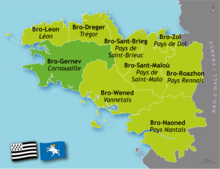Cornouaille
Cornouaille ( Breton: Kerne or Bro Gerne ) is a historic landscape in the Finistère department in Brittany . It was a kingdom in the Middle Ages and later part of the Duchy of Brittany. (see list of rulers of Brittany and list of bishops of Cornouaille )
etymology
The name leads to confusion with the English county of Cornwall , which is also called Cornouailles (plural of Cornouaille) in France . This is what the British speak of Brittany when they mean Brittany.
location
The Cornouaille extends from the Pointe du Raz in the extreme northwest to Quimperlé in the southeast. In the north it borders on the hinterland of Brest , in the south on the Atlantic . The historic landscape stretched eastward to the Landerneau , Morlaix and Quimperlé region via the future capital and the bishopric of Quimper (now approx. 60,000 inhabitants) of the Cornouaille . The coastal section of the Bay of Audierne stretches from the rocky peninsula Cap Sizun with the Pointe du Raz to the southern peninsula Presqu'île de Penmarc'h (its name comes from the pictorial horse head of this peninsula) and the lighthouse Phare d'Eckmühl .
Part of the historic Cornouaille is the western part with the Pays Bigouden and its capital, Pont-l'Abbé . The head covering of the female population (the Coiffe Bigoudène ), which has always been tall and shaped like towers of cloth , gave Bigoudenland its name. Allegedly it was a silent protest against the arbitrary persecution after the revolt against the paper tax in 1675 by Louis XIV . a. demolish numerous church towers in the Pays Bigouden. This stretch of land was once very prosperous and stretched across the Penmarc'h peninsula between the banks of the Odet and Goyen to the Bay of Audierne. Even among the Bretons they had a life of their own: “Hebken” - “This is how we are and this is how we stay” was the motto in life, similar to “Mir san mir” in Bavaria.
The country is characterized by enclosed parishes , which, according to old tradition, separate the world of the living and the dead. Also Calvaires , the oldest is Tronoën , are here frequently.
Buildings
Numerous megalithic structures : Cairn by Kerléven in La Forêt-Fouesnant , dolmen by Quélarn in Lesconil , Pointe de la Torche , Castel-Ruffel in Saint-Goazec and Ti Ar Boutiged , menhirs , alignments ( rows of stones from Lagatjar ) and buildings of the upper class are still there today at the "end of the world" (Finis-terre) to be marveled at.
Cider
The cider of the same name is produced in Cornouaille and has been a product of protected origin since 2000 . The production area of the fruit wine produced since around the 14th century is limited to the Finistère department .
Legend
At Plomarc'h on the “Plage du Ris”, a king Marc'h is said to have resided in a now ruined castle, who is said to be identical to King Marke from Tristan and Isolde . Later, King Gradlon is said to have fled to Quimper while fleeing the sinking city of Ys .
Attractions
- Concarneau
- Locronan
- Penmarc'h Peninsula and Museum
- Necropolis at the Pointe de Souc'h
- Pointe de la Torche
- Pointe you Raz
- Pont-Croix
- Quimper
- Calvary of Notre-Dame de Tronoën , in Tronoën
- Parc Botanique de Cornouaille
literature
- Serge Duigou, Jean Failler: La Cornouaille: Un territoire unique. Editions Palantines, 2013, ISBN 978-2-35678-086-7 .
- Federation Francaise de la Randonnee Pedestre: Cote de Cornouailles GR34 De La Pointe au Raz aux Mont. Noires: FFR.0348 from FFRP. Paris 2012, ISBN 978-2-7514-0610-2 .
- Denis Clavreul: La Cornouaille: De Quimper à la Pointe du Raz. Equinoxe, 2006, ISBN 2-84135-499-7 .
- Alexandra Beilharz (revision): Bretagne. (Michelin Green Guide). Travel-House-Media, Munich 2007, ISBN 978-3-8342-8992-6 .
- Daniel Michel: Cornouaille: Autour de Quimper et Concarneau. Clermont-Ferrand, Chamina 2012, ISBN 978-2-84466-202-6 .
- Michel Siou: La cornouaille. Editions Alan Sutton, 2006, ISBN 2-84910-544-9 .
- Hilke Maunder: Brittany. (Baedeker Allianz travel guide). Baedeker, Ostfildern 2010, ISBN 978-3-8297-1025-1 .
- Manfred Görgens: Brittany. (DuMont travel paperback). DuMont-Reiseverlag, Ostfildern 2010, ISBN 978-3-7701-7215-3 .
- Brigitte Maier, Gabriele Rupp (Red.): Bretagne. Dorling Kindersley, Munich 2013, ISBN 978-3-8310-2316-5 .
- Wolfgang Veit (Red.): Brittany. HB-Verlag, Ostfildern 2005, ISBN 3-616-06184-9 .
Individual evidence
- ^ Jean Lemoine: La Révolte Dite Du Papier Timbré, Ou, Des Bonnets Rouges En Bretagne En 1675. Etude Et Documents. Champion, Paris 1898, OCLC 6977861 . ( Révolte du papier timbré. In the French Wikipedia)
- ^ Entry on Cornouaille in the Database of Origin and Registration (DOOR) of the Directorate-General for Agriculture and Rural Development of the European Commission .


